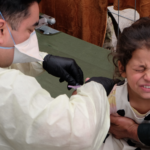Even as omicron infections trend down, long COVID remains a threat to the military
By Yong-Bee Lim | February 16, 2022
 The USS Theodore Roosevelt pictured shortly before a COVID-19 outbreak forced the ship to dock so that its crew could be tested. Credit: US Navy photo.
The USS Theodore Roosevelt pictured shortly before a COVID-19 outbreak forced the ship to dock so that its crew could be tested. Credit: US Navy photo.
As the omicron wave of COVID-19 subsides, it is clear society dodged one bullet; the highly transmissible variant that readily infects the vaccinated has proven less virulent than it could have been. As infections have plummeted, governors and other officials across the United States have raced to put the pandemic in the rear-view mirror and lift public health measures—actions that go against the recommendations of experts who say the virus could surge back.
Even if the rapid rise and fall of the “mild” omicron variant does signal an easing of the pandemic for now, there’s another bullet we may not be able to dodge: long COVID. The array of poorly understood respiratory, vascular, neurological, and other symptoms that can persist for even a full year after hospitalization in many COVID patients may yet exact a heavy toll on individuals and society. Long COVID could drag down businesses and the economy. Countries will have to consider how to bear the costs of care for citizens. And importantly, long COVID could also jeopardize US national security.
The US military got an early lesson in how COVID-19 could affect operations in March 2020 when several sailors on the USS Theodore Roosevelt, an aircraft carrier that had been deployed in Asia, tested positive after shore leave in Vietnam. The Navy had to take the ship out of commission as it tested 5,000 crew members for COVID-19. The Pentagon had another scare when Secretary of Defense Lloyd Austin, who was fully vaccinated and boosted, publicly announced that he had tested positive for COVID on January 2.
The USS Theodore Roosevelt and Austin’s brush with COVID highlight the complexity and fragility of US military operations at specific points in time. Long COVID, however, presents what may turn out to be a lasting challenge to US military operations.
I tested positive this morning for COVID-19. I requested the test today after exhibiting symptoms while at home on leave. My symptoms are mild, and I am following my physician’s directions. 1/7
— Secretary of Defense Lloyd J. Austin III (@SecDef) January 3, 2022
What is long COVID? Even after an acute COVID infection clears, a fairly large subset of people—perhaps 20 to 30 percent of adults and between 10 and 30 percent of children—go on to experience symptoms for a month or longer afterward. These include respiratory issues; headaches; joint and muscle pain; varying degrees of fatigue and malaise; and neurological symptoms, including “brain fog,” changes in smell or taste, and changes in mood. The condition affects numerous organ systems, including the heart, lungs, kidneys, skin, brain, and immune system. Even people with mild cases of COVID-19 can develop long COVID.
And long COVID symptoms have been observed in all age groups, from children and adolescents to the elderly, with some differences in how the constellation of symptoms manifests in these groups. Even vaccinated people who suffer a breakthrough infection can experience long COVID.
Reduced physical ability? An inability to think clearly? Heart problems? In the military context of people making life or death decisions, these issues could pose a real problem.
Implications of long COVID for national security. Disease threats have long been a serious consideration in the military; they’re one reason why the institution has played an important role in vaccine development throughout history. And Austin mandated that all servicemembers get vaccinated. As of December 2021, 98 percent of the active-duty force had received the COVID-19 vaccine.
But breakthrough cases have been on the rise in vaccinated people infected with omicron. This means that even service members who are fully vaccinated and boosted under the vaccine mandate still face the possibility of getting infected with COVID and, unfortunately, developing long COVID symptoms after their initial infection clears. And getting COVID or long COVID once is no guarantee of not getting them again; reinfections happen and, anecdotally, they can lead to new or worse long COVID symptoms. Given that the prevalence of long COVID could be up to 30 percent for adults who have had COVID-19, the Defense Department needs to consider that long COVID might cause attrition that reduces force readiness. This increased attrition may not be felt immediately.
A study last fall found that half of long COVID sufferers could not return to work. “Our work and the work of others has shown that this affects people’s abilities to make plans, synthesize information, and do their daily activities of work,” David Putrino, the director of rehabilitation innovation at Mount Sinai Hospital in New York told CNBC. “They suffer from a lot of memory loss and inability to form new memories, as well as difficulty with speaking. This is a very debilitating condition with serious cognitive conditions.”
The military is used to people leaving at the end of their deployments or as they retire. It is built to handle fairly substantial losses in manpower and replace 15 to 20 percent of its force each year. If long COVID sidelines more people, that figure could increase.
On a strategic level, long COVID could affect key people in the Pentagon’s structure. Austin spent time isolating and working remotely after his COVID scare. Recently, he’s been talking with Japanese and Korean defense officials about North Korean missile tests and doing other work; he appears to have recovered well. But if long COVID affected a defense secretary or other top officials who would be difficult to replace in the short term, that might pose real strategic issues.
Studies show that vaccination can reduce the risks of developing long COVID. Still, considerable steps should be taken beyond the vaccine mandate to minimize possible COVID exposure to US military and civilian leaders when possible. This includes building testing capacity, providing for rigorous contact tracing, and making sure that tools like masking, physical distancing and quarantining are used, as the situation requires.
As people navigate an evolving pandemic reality, some will want to return to pre-pandemic normal and push to reverse public health and legal measures like vaccine mandates. Even if such a future doesn’t precipitate a dangerous surge in cases, it is clear that society needs both a better understanding of long COVID and a plan to address it going forward. Long COVID is going to be a society-wide problem. Employers will have to adjust as workers are not able to work, at least to the degree they previously worked. The government may have to rethink policies on addressing long-term and chronic illnesses.
In the military, leaders will have to grapple with how to maintain the size of the armed forces and how to respond should long COVID affect key people in the chain of command. Already, Austin is having the Department of Defense undertake a Biodefense Posture Review. The first review of its kind in Defense Department history, it is meant to “assess the biological threat landscape and establish the Department’s approach to biodefense, to include clarifying biodefense priorities, roles, responsibilities, authorities, capabilities, and posture.” The Pentagon should finish review in mid-2022. It is an opportunity to consider a variety of issues, including how long COVID could impact service members and key individuals in both the military and civilian chain of command.
Even if the “full blown” phase of the pandemic is receding, as Anthony Fauci, the director of the National Institute of Allergy and Infectious Diseases, recently said, COVID isn’t over. The United States will have to think carefully about how the coronavirus’s long-term consequences could affect national security.
Together, we make the world safer.
The Bulletin elevates expert voices above the noise. But as an independent nonprofit organization, our operations depend on the support of readers like you. Help us continue to deliver quality journalism that holds leaders accountable. Your support of our work at any level is important. In return, we promise our coverage will be understandable, influential, vigilant, solution-oriented, and fair-minded. Together we can make a difference.
Keywords: COVID-19, US military, long COVID
Topics: Biosecurity, Disruptive Technologies















